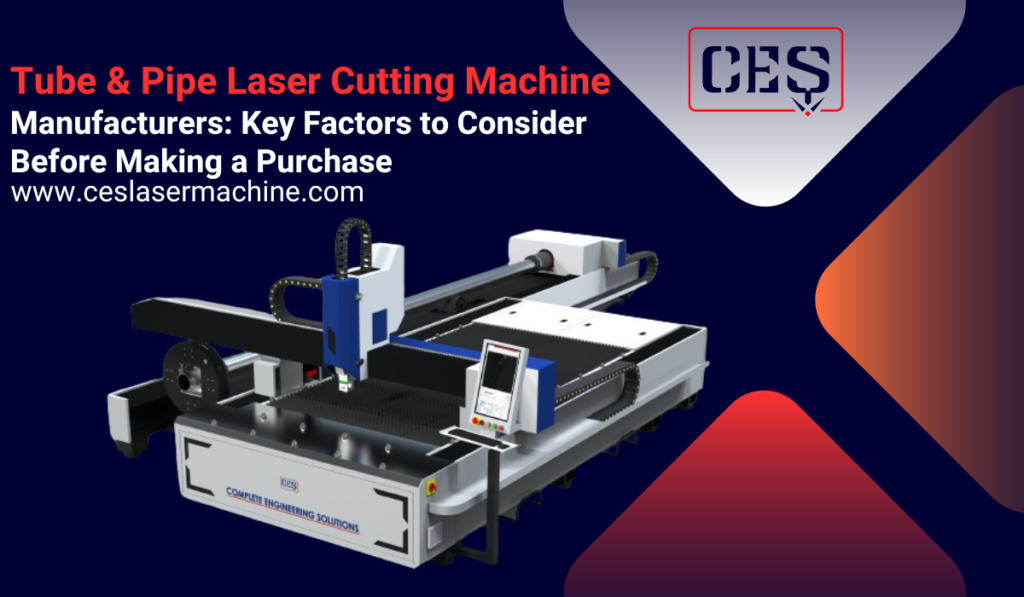In the realm of industrial manufacturing, tube and pipe laser cutting machines have revolutionized the way intricate designs are fabricated from metal tubes and pipes. These machines offer precision, efficiency, and versatility, making them indispensable tools for a wide range of industries, including automotive, aerospace, and construction. However, with a plethora of manufacturers vying for attention in the market, choosing the right tube and pipe laser cutting machine can be a daunting task. To assist you in making an informed decision, let’s delve into the essential factors to consider before investing in tube and pipe laser cutting machines at CES Laser.
Cutting Capabilities
- Tube and Pipe Diameter Range: Assess the machine’s capability to cut across various tube and pipe diameters effectively. Confirm that it meets the specific diameter requirements of your production needs.
- Material Compatibility: Check if the machine can cut various materials such as stainless steel, aluminum, copper, and brass. Different manufacturers may offer different material compatibility.
- Thickness Capacity: Evaluate the maximum thickness the machine can handle. This is crucial for ensuring compatibility with your intended materials and applications.
Laser Technology
- Fiber vs. CO2 Lasers: Understand the differences between fiber and CO2 laser technologies. Fiber lasers are known for their high efficiency and low maintenance, while CO2 lasers are preferred for thicker materials and certain applications.
- Power Output: Consider the laser power output offered by the machine. Higher power typically results in faster cutting speeds and improved performance, especially when dealing with thicker materials.
Accuracy and Precision
- Positioning Accuracy: Look for machines that offer high positioning accuracy to ensure precise cutting of intricate designs.
- Repeatability: Evaluate the machine’s repeatability, which determines its ability to reproduce cuts accurately over multiple runs. Consistent repeatability is essential for maintaining quality and minimizing material waste.
Automation and Integration
- Automatic Loading and Unloading: Some machines feature automatic loading and unloading systems, which can significantly enhance productivity by reducing manual intervention.
- Software Integration: Check if the machine integrates seamlessly with CAD/CAM software for efficient design-to-cut workflows. Compatibility with industry-standard software can streamline operations and maximize productivity.
Maintenance and Support
- Service and Support: Research the manufacturer’s reputation for customer support and maintenance services. A responsive support team and readily available spare parts can minimize downtime and ensure smooth operations.
- Training and Resources: Determine if the manufacturer offers comprehensive training programs and resources to help your operators optimize machine usage and troubleshoot common issues.
Safety Features
- Enclosure and Safety Interlocks: Ensure the machine is equipped with safety features such as enclosures and interlocks to protect operators from potential hazards associated with laser cutting.
- Emission Control: Verify that the machine complies with relevant safety standards for laser emission control to safeguard both personnel and the environment.
Cost Considerations
- Initial Investment: Evaluate the upfront cost of the machine and compare it with your budget constraints. Keep in mind that investing in a higher-quality machine may result in long-term cost savings through improved productivity and reliability.
- Operating Costs: Consider factors such as energy consumption, maintenance requirements, and consumable expenses when assessing the overall cost of ownership.
Conclusion
Selecting the right tube and pipe laser cutting machine manufacturer requires careful consideration of various factors, including cutting capabilities, laser technology, accuracy and precision, automation and integration, maintenance and support, safety features, and cost considerations. By thoroughly evaluating these key factors and choosing a reputable manufacturer that aligns with your specific requirements, you can make a confident investment that enhances your manufacturing capabilities and drives business success.

